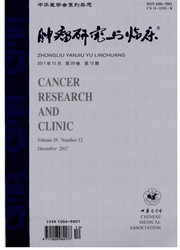

 中文摘要:
中文摘要:
目的检测NY—ESO-1蛋白在喉鳞癌中的表达情况,探讨其作为喉癌免疫治疗靶标的实验依据及其与喉癌生物学行为的关系。方法免疫组织化学PV一9000两步法检测69例喉鳞癌患者原发灶及其常规病理报告为阳性的121个颈淋巴结中NY—ESO一1的表达,同时采用Westernblotting方法检测其在喉鳞癌标本的癌中心区、癌周0.5、1.0cm及9例全喉切除术患者的喉正常黏膜组织(对照)中的表达。结果69例喉鳞癌组织中,NY—ESO一1蛋白表达阳性率为43.48%(30/69),在癌中心区、癌周0.5、1.0cm中的表达逐渐下降(P〈0.05),NY—ESO一1在对照组喉正常黏膜组织中无表达。NY—ESO一1蛋白在不同T分级、病理分级和不同颈淋巴结转移喉癌中的表达率差异无统计学意义(P〉0.05),颈转移淋巴结中NY—ESO一1的表达下调。结论NY—ESO一1在喉鳞癌患者中特异性高表达,可能以某种方式参与了喉癌的发生、发展,是否能将其作为喉癌免疫治疗靶标有待深入研究。
 英文摘要:
英文摘要:
Objective To detect the expression of Cancer-Testis antigen NY-ESO-1 in human laryngeal squamous carcinoma (LSC) and to explore its significance in immunotherapeutic application. Methods The expressions of NY-ESO-1 protein in the LSC and in the pathologically positive lymph nodes were detected by PV-9000 Immunohistochemistry. Western blotting was also employed to measure the expressions of NY-ESO-1 in the tumor core region(TC), the tissues at the sites of 0.5cm, 1.0cm away from LSC periphery and the distant normal larynx tissues. Results NY-ESO-1 protein expression was positive in 30 out of 69 (43.48 %) cases of LSC. The expression level of NY-ESO-1 protein were found to significantly decrease by turns in TC and corresponding adjacent tissues (P 〈0.01). None of the nine normal larynx tissues expressed NY-ESO-1 protein. It did not display an obvious correlation between the expression of NY-ESO-1 with T staging, pathological grading and lymph node metastasis (P 〉0.05). Its positive expression was found in pathologically positive cervical lymph nodes, which were significantly lower than that in the primary site (P 〈0.05). Conclusion NY-ESO-1 protein express at high level in human laryngeal squamous carcinoma, and they may play a role in genesis and development of tumors, which suggests that NY-ESO-1 gene might be used as target antigens for immunotherapy of LSC and the further research is necessary.
 同期刊论文项目
同期刊论文项目
 同项目期刊论文
同项目期刊论文
 期刊信息
期刊信息
